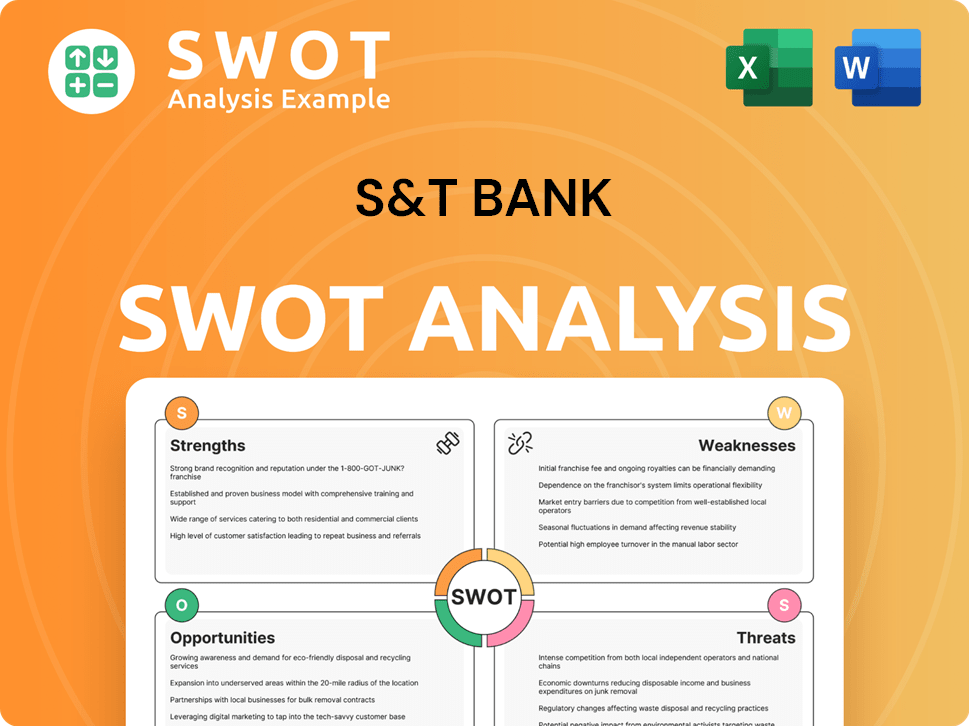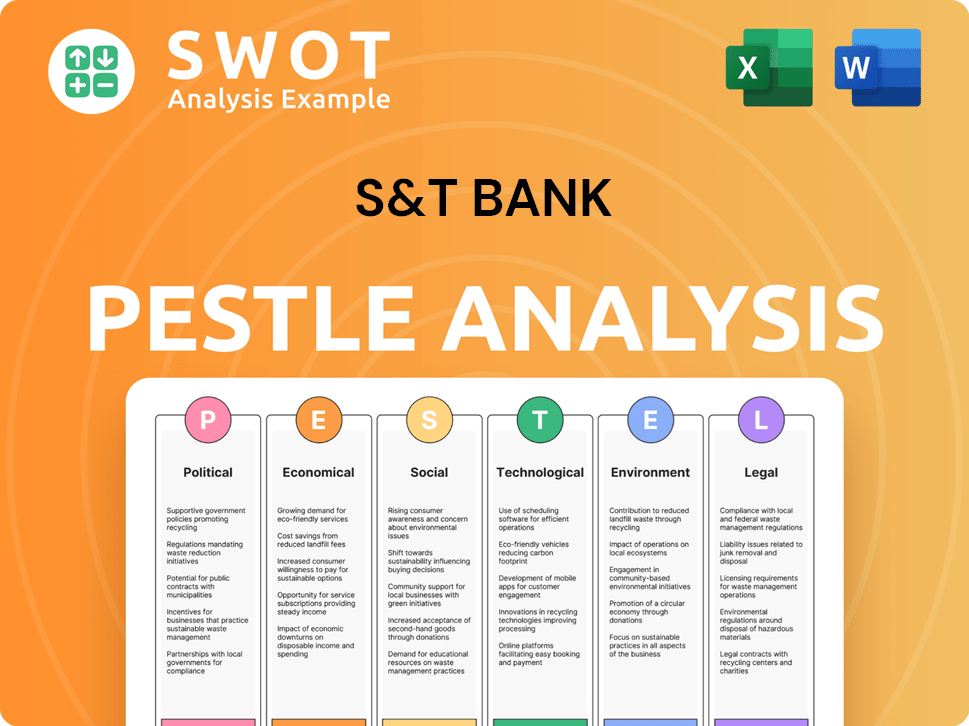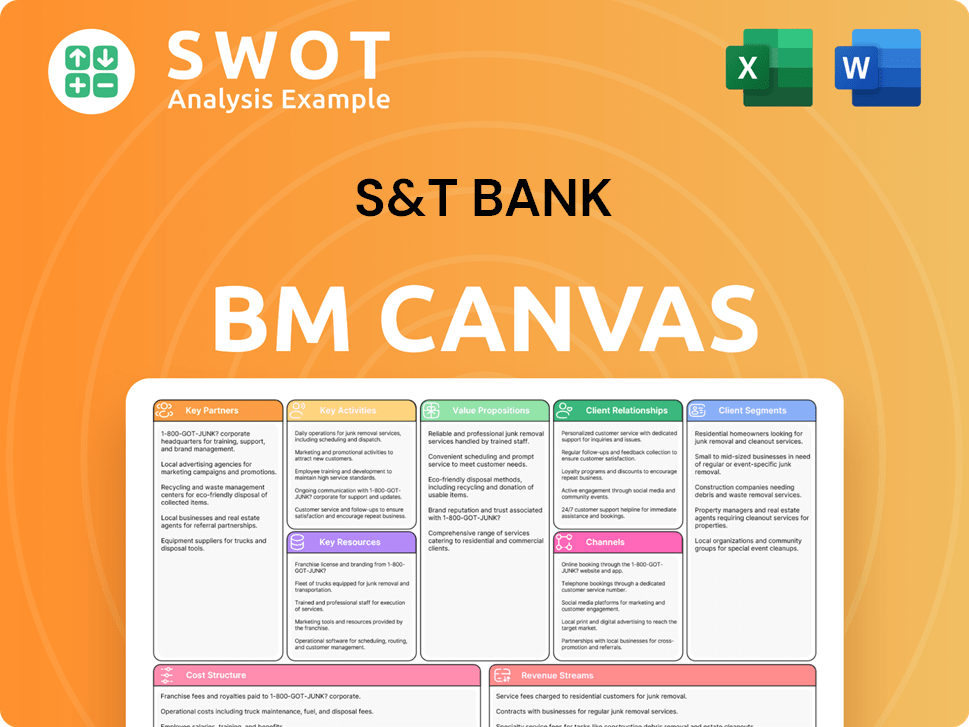S&T Bank Bundle
How Does S&T Bank Stack Up Against the Competition?
In the ever-evolving world of regional banking, understanding the S&T Bank SWOT Analysis is crucial. With the industry experiencing significant shifts due to digital transformation and consolidation, the competitive landscape is more complex than ever. This analysis delves into S&T Bank's position, exploring its rivals, advantages, and strategies for success.

This S&T Bank market analysis provides a comprehensive view of its S&T Bank competitive landscape, including S&T Bank competitors and their impact on its S&T Bank financial performance. We'll examine its S&T Bank industry analysis to understand the bank's strategic positioning within the regional banking sector. Furthermore, we will explore S&T Bank business strategy to highlight how it navigates the challenges and opportunities in a dynamic market.
Where Does S&T Bank’ Stand in the Current Market?
S&T Bank holds a strong regional market position, primarily focused on Western Pennsylvania, with an expanding presence in Central Pennsylvania, Northeast Ohio, and Upstate New York. The bank's core operations revolve around providing a comprehensive suite of financial products and services to a diverse customer base. This includes commercial and retail loans, deposit products, and wealth management services.
As of December 31, 2024, S&T Bancorp reported total assets of approximately $9.4 billion, reflecting its substantial scale within the regional banking sector. Its value proposition lies in offering personalized service and community-focused banking, while also embracing digital transformation to enhance customer experience and operational efficiency. This combination allows the bank to compete effectively against both smaller community banks and larger regional and national institutions.
The bank's primary product lines include a robust offering of commercial and retail loans, such as commercial real estate, commercial and industrial, and consumer loans, alongside a diverse portfolio of deposit products like checking, savings, and money market accounts. S&T Bank also provides comprehensive wealth management services, including trust and investment management, and insurance services, catering to a broad spectrum of customer segments from individuals and small businesses to larger corporations and institutions.
S&T Bank consistently ranks among the top financial institutions in many of its core Western Pennsylvania markets. In Indiana County, Pennsylvania, where it was founded, it maintains a dominant market presence. While precise market share figures fluctuate, the bank's strong regional footprint is evident.
Expansion into new territories like Ohio and New York reflects a strategic move to diversify geographic revenue streams and strengthen overall market standing. This expansion is part of a broader strategy to increase its competitive advantage and enhance its position within the Brief History of S&T Bank.
S&T Bank has strategically shifted its positioning over time, embracing digital transformation to enhance customer experience and operational efficiency. This includes investments in online and mobile banking platforms to meet evolving customer needs and compete with fintech offerings.
The bank leverages its community ties and personalized service to compete with larger regional and national banks. Its financial health, as indicated by its asset size and consistent profitability, generally positions it favorably compared to many smaller community banks.
S&T Bank's market position is shaped by its regional focus, strong customer relationships, and strategic investments in digital technology. The bank's ability to balance its traditional banking model with modern digital offerings is crucial for maintaining its competitive edge.
- Strong regional presence in Western Pennsylvania, with expansion into new markets.
- Comprehensive suite of financial products and services for diverse customer segments.
- Emphasis on personalized service and community banking.
- Strategic investments in digital transformation to enhance customer experience.
S&T Bank SWOT Analysis
- Complete SWOT Breakdown
- Fully Customizable
- Editable in Excel & Word
- Professional Formatting
- Investor-Ready Format

Who Are the Main Competitors Challenging S&T Bank?
The Marketing Strategy of S&T Bank operates within a dynamic and competitive financial services sector. Understanding the competitive landscape is crucial for assessing its market position and strategic direction. This analysis considers both direct and indirect competitors, examining their strengths, weaknesses, and impact on S&T Bank's performance.
The competitive environment for S&T Bank is shaped by a variety of players, including established regional banks, community banks, credit unions, and fintech companies. Each type of competitor presents unique challenges and opportunities. Analyzing these competitive dynamics is essential for evaluating S&T Bank's strategic positioning and future prospects.
S&T Bank faces a diverse array of competitors in the financial services industry. This competitive landscape includes regional banks, community banks, credit unions, and fintech companies, each vying for market share. Understanding these competitors is crucial for assessing S&T Bank's market position and strategic initiatives.
The most significant direct competitors are regional banks that overlap geographically and offer similar services. These banks often have larger asset bases and broader branch networks. Key players include Citizens Financial Group, PNC Financial Services Group, and KeyCorp.
PNC, headquartered in Pittsburgh, presents a formidable challenge due to its extensive presence across Pennsylvania and beyond. It offers a comprehensive suite of consumer and commercial banking products. As of Q1 2024, PNC reported total assets of approximately $562 billion.
Citizens Financial Group has a strong retail and commercial presence in S&T Bank's operating areas. It competes directly in the same markets, offering similar banking services. In Q1 2024, Citizens Financial Group reported total assets of around $222 billion.
S&T Bank also competes with numerous community banks that focus on specific local markets. These banks leverage deep community ties and personalized service. Examples include Dollar Bank and F.N.B. Corporation, which maintain a strong presence in parts of Pennsylvania and Ohio.
Dollar Bank is a significant competitor in local markets, known for its strong community focus. It offers a range of retail and commercial banking services. Dollar Bank's total assets were approximately $9.8 billion as of 2024.
Indirect competitors include credit unions, which often offer competitive rates and lower fees, and non-bank financial technology (fintech) companies. Fintech companies specialize in services like online lending and payment processing. The rise of fintech has significantly altered the competitive landscape.
The banking industry is subject to significant merger and acquisition (M&A) activity, constantly reshaping the competitive dynamics. Larger institutions acquire smaller ones to expand market share and capabilities. S&T Bank must adapt its business strategy to navigate this evolving landscape.
- Competitive Positioning: S&T Bank's ability to differentiate itself through customer service, digital offerings, and competitive interest rates is crucial.
- Strategic Advantages: Identifying and leveraging unique strengths, such as deep local market knowledge or specialized services, can help S&T Bank compete effectively.
- Growth Strategies: Exploring opportunities for organic growth, strategic partnerships, or acquisitions can enhance S&T Bank's market presence.
- Financial Performance: Monitoring and analyzing the financial performance of competitors, including their revenue, profitability, and market share, provides valuable insights.
- Digital Banking: Investing in and enhancing digital banking offerings is essential to meet customer expectations and compete with fintech companies.
S&T Bank PESTLE Analysis
- Covers All 6 PESTLE Categories
- No Research Needed – Save Hours of Work
- Built by Experts, Trusted by Consultants
- Instant Download, Ready to Use
- 100% Editable, Fully Customizable

What Gives S&T Bank a Competitive Edge Over Its Rivals?
Understanding the S&T Bank competitive landscape requires a close look at its strengths. The bank distinguishes itself through a community-focused approach, fostering strong customer relationships. This is particularly evident in its long-standing presence in Western Pennsylvania, where it has built a solid reputation over more than a century. Its ability to offer personalized financial solutions, combined with a diversified service portfolio, creates a competitive edge in the regional banking sector.
S&T Bank's strategic advantages are rooted in its commitment to customer service and technological advancements. The bank has invested in digital platforms to enhance customer convenience, while maintaining its personalized service. This blend of traditional values and modern technology allows it to remain competitive in an evolving financial landscape. The bank's focus on wealth management and insurance services also contributes to its ability to capture a larger share of customer financial needs.
The bank's regional scale allows for operational efficiencies, while maintaining the agility of a community bank. Its talent pool, which includes experienced relationship managers and financial advisors, further strengthens its competitive position. These advantages have evolved from a traditional community bank model to one that integrates modern financial services while retaining its core values of customer focus and community engagement. For more details on its business model, check out this article: Revenue Streams & Business Model of S&T Bank.
S&T Bank benefits from a strong brand reputation, especially in its core markets. This has been built over time through consistent service and community involvement. The bank's established presence fosters trust and loyalty among customers, providing a solid foundation for growth and stability.
The bank's localized knowledge enables quicker and more tailored financial solutions. This agility allows S&T Bank to respond effectively to customer needs. This is a key differentiator compared to larger financial institutions.
S&T Bank offers a range of services beyond traditional banking, including wealth management and insurance. This integrated approach allows the bank to serve a broader range of customer needs. This diversification supports multiple revenue streams.
Investments in technology and digital platforms ensure S&T Bank remains competitive. Enhancements to online and mobile banking provide customers with convenience. The bank combines digital capabilities with personalized service.
S&T Bank's competitive edge stems from its community focus, customer loyalty, and diverse service offerings. Its localized decision-making and digital transformation initiatives further strengthen its position. These factors contribute to its ability to compete effectively in the S&T Bank competitive landscape.
- Strong brand reputation and customer loyalty in core markets.
- Localized knowledge and decision-making for tailored solutions.
- Diversified services, including wealth management and insurance.
- Commitment to digital transformation for enhanced customer convenience.
S&T Bank Business Model Canvas
- Complete 9-Block Business Model Canvas
- Effortlessly Communicate Your Business Strategy
- Investor-Ready BMC Format
- 100% Editable and Customizable
- Clear and Structured Layout

What Industry Trends Are Reshaping S&T Bank’s Competitive Landscape?
The banking sector is experiencing significant shifts, impacting institutions like S&T Bank. Key trends include the rise of digital banking, evolving customer expectations, and increased regulatory scrutiny. These changes necessitate strategic adaptation to maintain a competitive edge. Understanding the S&T Bank competitive landscape requires a deep dive into industry dynamics and the strategies of its rivals.
S&T Bank's market analysis reveals both challenges and opportunities. The rise of fintech companies and the potential for economic downturns pose risks. However, expansion into underserved markets and innovation in product offerings present avenues for growth. This analysis is vital for shaping S&T Bank's business strategy.
The banking industry is heavily influenced by technological advancements, with digital banking and mobile payments becoming increasingly prevalent. Regulatory changes, particularly those concerning consumer protection and data privacy, are also reshaping the landscape. Consumer preferences are shifting towards more personalized and convenient banking services.
Intensified competition from fintech companies is a significant challenge, as these firms gain market share in niche financial services. Economic downturns could impact loan portfolios. Industry consolidation may lead to larger, more formidable competitors. These challenges demand proactive strategies.
Expansion into underserved markets, especially through digital channels, presents a growth opportunity. Innovation in product offerings, such as specialized lending, can attract new customer segments. Strategic partnerships with fintech firms can integrate new technologies. Maintaining strong community ties is also a competitive advantage.
S&T Bank can leverage its regional market strengths and embrace digital transformation to navigate challenges and capitalize on opportunities. Focusing on personalized service and community engagement will be crucial. Understanding the strategies of S&T Bank competitors is essential for maintaining a strong market position.
To thrive, S&T Bank should focus on strategic initiatives to address industry trends and challenges. This includes enhancing digital banking capabilities, adapting to regulatory changes, and meeting evolving customer expectations. Proactive measures are essential for sustained S&T Bank financial performance.
- Investing in cybersecurity and IT infrastructure to protect financial data.
- Developing innovative product offerings, such as specialized lending for small businesses.
- Exploring strategic partnerships with fintech companies to integrate new technologies.
- Leveraging its strong community ties and personalized service model.
For a deeper dive into the growth strategies of S&T Bank, consider the insights presented in the article: Growth Strategy of S&T Bank. This offers a comprehensive view of how S&T Bank is positioning itself in the competitive banking sector. As of Q1 2024, the bank reported a net income of $20.3 million, reflecting its ongoing efforts to adapt and grow within the industry. Furthermore, the bank's focus on digital transformation and community engagement continues to be key drivers of its strategic initiatives.
S&T Bank Porter's Five Forces Analysis
- Covers All 5 Competitive Forces in Detail
- Structured for Consultants, Students, and Founders
- 100% Editable in Microsoft Word & Excel
- Instant Digital Download – Use Immediately
- Compatible with Mac & PC – Fully Unlocked

Related Blogs
- What are Mission Vision & Core Values of S&T Bank Company?
- What is Growth Strategy and Future Prospects of S&T Bank Company?
- How Does S&T Bank Company Work?
- What is Sales and Marketing Strategy of S&T Bank Company?
- What is Brief History of S&T Bank Company?
- Who Owns S&T Bank Company?
- What is Customer Demographics and Target Market of S&T Bank Company?
Disclaimer
All information, articles, and product details provided on this website are for general informational and educational purposes only. We do not claim any ownership over, nor do we intend to infringe upon, any trademarks, copyrights, logos, brand names, or other intellectual property mentioned or depicted on this site. Such intellectual property remains the property of its respective owners, and any references here are made solely for identification or informational purposes, without implying any affiliation, endorsement, or partnership.
We make no representations or warranties, express or implied, regarding the accuracy, completeness, or suitability of any content or products presented. Nothing on this website should be construed as legal, tax, investment, financial, medical, or other professional advice. In addition, no part of this site—including articles or product references—constitutes a solicitation, recommendation, endorsement, advertisement, or offer to buy or sell any securities, franchises, or other financial instruments, particularly in jurisdictions where such activity would be unlawful.
All content is of a general nature and may not address the specific circumstances of any individual or entity. It is not a substitute for professional advice or services. Any actions you take based on the information provided here are strictly at your own risk. You accept full responsibility for any decisions or outcomes arising from your use of this website and agree to release us from any liability in connection with your use of, or reliance upon, the content or products found herein.